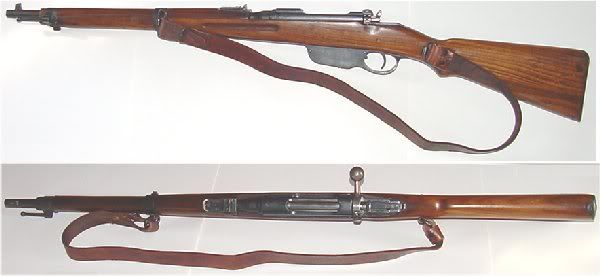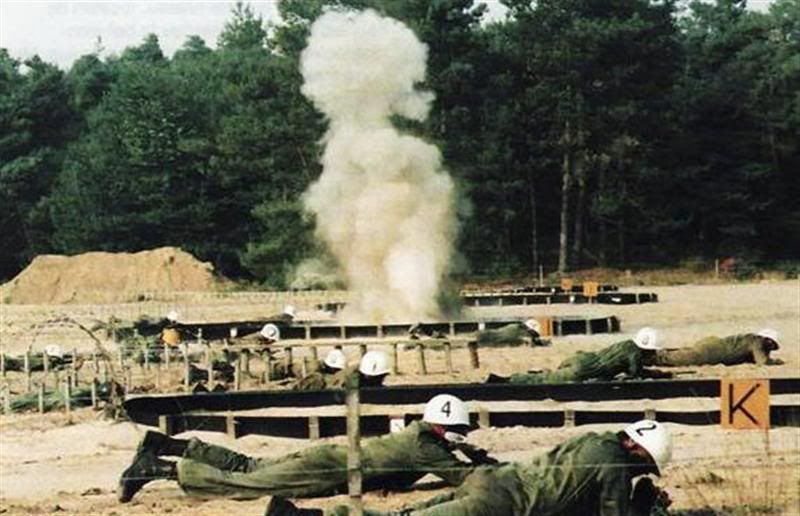In the Netherlads on the Veluwe near the small village of Harskamp the Dutch army owns a large complex of shooting ranges.
This military complex dates back from 1895.
I will describe its history in the following article.
link to pictures of the barracks at harskamp.
http://www.legerplaats.nl/harskamp/_harskamp.htmShooting range Harskamp, Infanterie Schietkamp harskamp, ISKIn 1895 an important change took place within the Dutch army, a lot of units had different types of rifles with short range fire capability.
The high command decided to buy a new weapon, one which was very modern for the time, The
Mannlicher M95.
Its effective range was 1500 meters, therefore the need arose to build a new shooting range.

The old ranges were located near towns with garrisons and could only handle 200 meters, so because of safety issues the army decided to build a new range.
The secretary of war decided after some time (in 1896) that the new range should be sited at the Veluwe, a large rural/forested area in the east of the country near the town of
Harskamp.
The terrain earmarked for the base was 3000 hectares big.
In the summer of 1899 most of the work was done and by september 1 a unit from Amersfoort held the first firing-exercises.
All tests were carried out with full satisfaction and the range became fully operational in the spring of 1900.
5 ranges were available to the troops.
On 2 ranges soldiers could shoot at moving targets as well.
The new range meant a change for Harskamp, a sleepy average farmersvillage.
Allthough the exercises meant more noise and some inconvenience, soon the villagers also knew that they could make money out of the soldiers.
They sold fruit, vegetables, tobacco and other stuff to the men and many locals could work on and support the base.
From the beginning cooperation and tolerance between civilians and soldiers has been good , which it still is today.
In this early period the infantry only trained during spring and summermonths.
They were stationed on a large area of the base named the Zuiderheid in tents.
A 100 men strong company took care of the base and the soldiers.
All infantryunits had to walk to the base, allways accompanied by a band which played loud military marching music.
Units from other areas of the country arrived by train and disembarked at Stroe or Ede station, this took about 3 hours on average.
The units at Amersfoort and nearby units had to walk the entire distance to the camp.
At the camp itself all movement was done on foot, accept for the officers.
They could move by horseback.
Transportation of targets and ammo was done by horse drawn wagons.
The soldiers woke up for reveille by the firing of a gun at 05.00 in the morning, this was also done to anounce change of afternoon and evening shifts.
The men ate in the field near their tents.
At the end of the day they had to clean up and wash their own clothes used during the exercises.
For the few leisure hours the men had, a home was build outside the base, this home still exists today.
However there wasnt much luxury for the enlisted men.
1914-1940 (Interbellum)
During this period the ISK changed.
The first world war saw the mobilisation of thousands of extra soldiers which needed training.
New barracks to accomodate soldiers were needed and build everywhere, ISK received new plumbing too.
Old waterpumps were replaced by new ones and the base received electricity.
The war lasted longer than expected by the government, this lead to problems among the men.
At ISK there was nothing to do for the men, (and to make it worse in 1918 there was an outbreak of the Spanish flu) the men were needed badly at the factories and in the fields.
When the High command issued an order to cancel all leaves, riots broke out.
After the great war ended, the army demobilized.
For a long time( due to defense cuts) it remained silent in Harskamp.
But that did not mean nothing happened, new units trained at ISK since 1928.
Important improvements were made, transport of ammo and targets was by now done by train.
About 23 km of railwaytracks connected all parts of ISK, ( the train and parts of the railwaytrack are viewable at the museum)
Corvee was very popular, working at the ammotransport meant that a soldier could move by train instead of walking to the distant ranges.
In the 1930s the camp grew bigger again.
Nazi Germany rising to power was seen as a danger to the Dutch neutrality, and allthough Holland declared its neutrality again and again the government decided to mobilize the army again nonetheless.
By now the army had a new rifle, the Hembrug, as well as heavy mg08 machineguns, mortars and light
lewis machineguns.
This meant that 4 new ranges were added, bringing the total to 9.
They were now all ready to accomodate the new machineguns and mortars.
Another new item was the handgrenade practice range and a range to practice wih firing anti-air machineguns.
The kitchens, sanitary buidings and baracks were modernized to the new 30/40's standards.
1940-1990After the capitulation of the Dutch army the Germans took over the base, and from june 27 1940 German units trained at ISK.
In 1945 the germans were driven out of the country, the ISK was used by the Canadians to imprison Dutchmen who served with the SS.
In june that same year Dutch troops took over the camp, the regiment Stoottroepen was responsible for guarding and adminstrative tasks.
In 1946 the last prisoner was released from ISK and that same year ISK returned to its old prewar status.
The army had new weapons and the operational ideas of how to wage war changed after the war.
Again ISk stood on the brink of a change.
The base became bigger and the existing ranges were modernized and enlarged.
In 1956 a small village was created to train urban warfare named Oostdorp.
In 1958 the army received its first infra-red vision equipment, this meant that the units could now shoot in the evening and at night.
Another important change in the 60/70's was the introduction of new weapons like the 84mm Carl gustav, the LAW , the MAG mg, FAL rifle m2 0.50 cal and the uzi.
On the westerheide ranges were equiped with electrically operated targets.
In 1962 new vehicles entered the arsenal of the armored infantry, before that infantry had been motorised.
When the YPR came into service with its 25mm canon the ranges were enlarged again, this weapon could fire at 2000 meters.
A new item in the 70s was the ATGM, Dragons and Tows were issued to the troops.
A new anti-tank range was buld to train and fire with these weapons.
Every enlisted soldier was allowed to fire 1 such missile in his draft periode.
In the 80s the infantry combat range was modernized too.
A new command and control tower overlooked the entire range.
From there all targets could be operated and controlled.
One range was modernized to be used for lasertargets.
Some ranges on the Westerheide were fitted with moving targets.

Soldiers at the infantry combat range!
1990-2000In 1990 the German wall fell, this had consequences for NATO.
Most people thought defense budgets would shrink because of the new russian politic of Perestoika.
Armies would soon reorganise and shrink in size, in the Netherlands the draftsystem was abandoned and the military transformed into a professional army after 1995.
At ISK personell was afraid of losing work, but this proved not to be the case.
More branches of the government like the police, andall other services of the armed forces started to train at ISK.
Where units disappeared others grew in size like the NATRES.
The army changed the 70's arms for new types.
Diemaco, MAG, MINIMI, 40 mm grenadelaunchers, 35mm guns and new mortars came into the inventory.
A new range was made for armored infantry fighting vehicles.
Soldiers now are trained to operate their weapons in all kinds of tactical circumstances.
Before he enters the range he is trained how to use his weapon in the virtual training rooms(KKW sim)
than he goes to the ISK, here he is trained in 3 levels of readiness.
basic rifleman, combat rifleman and groups combatrifleman.
Improvements were made to the ranges as well.
All targets on the ranges are now radiocontrolled and usable up to 3000 meter.
2000 till now.Operations changed, units were sent on peace (enforcement) missions.
Accept for the standard combat units all other units trained 1 or 2 times per year at ISK.
The missions abroad proved that most of the operational drills of logistics and supportunits were not good.
High command came up with new standard drills for contact, every unit has to train these drills several times a year.
The same applied to tank and AFV crews, patrolling outside the vehicle on foot became standard drill for them too.
The royal miltary police started using more of ISK because their personell had to be familiar as wellwith the new weapons and tactis/drills.
The marines used a shooting range in Amersfoort, this was closed and now they also shoot at ISK.
The old static exercises like firing at standard targets steadily changed.
Now we practice contact drills, moving forward and backwards while firing, and more.
New weapons like the GILL ATGW and the CV9035 vehicle shown the need for new improvements and modernications.
MuseumNear the base is a museum about the history of ISK, next to it is the museum for the NATRES.
Both are worth a visit!
Nature and environment,The MoD has rules and laws regarding mother nature.
Most of the exercisegrounds are the countries most beautifull nature areas.
Some of them are official wildparks, a lot of animals and endangered/rare plants flowers are to be found on military terrains.
Especially the terrain between the various shootingranges has numerous animals and plants, because nobody ever comes there.
Needless to say that most of the left winged naturefreaks are looking to these terrains with envying eyes

Sometimes this leads to accidents, recently a deer was shot by accident.
At the ranges special houses are build with reservoirs to collect oil and prevent other chemical substances from entering the environment.
At the base a firefighter unit is present to, they are well equiped to engage fires everywhere on the terrain of ISK.
Specially during (dry)summer months the heath can catch fire by bullits or smoke rounds or phosphor from illuminating rounds.
Link to pictures of the firefighters equipment
http://www.brandweer.org/voertuigen/isk-harskamp.html










